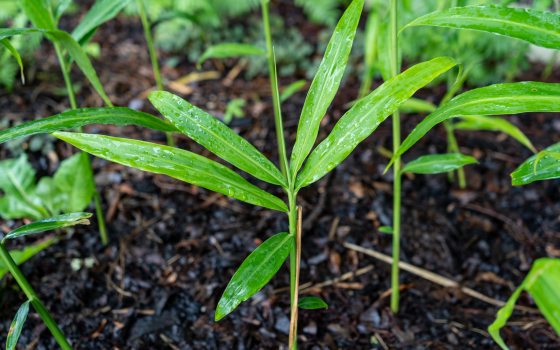These days, a visit to our Idea Garden serves as a mini-visit to the tropics … and not just because of the flock of flamingoes wading in the nearby Chimes Tower basin, thanks to Light: Installations by Bruce Munro. From fragrant dwarf cardamom to vibrant mandarinquats, a variety of tropical herbs and plants are thriving in our Idea Garden, all of which can be reliably grown and enjoyed by home gardeners in the mid-Atlantic region. Some are annuals we start from seed each year, some have tubers or rhizomes that can be overwintered and replanted the following year, and some live in pots that can be moved indoors for the winter. Here are a few of our favorites and how best to grow them.
Ginger (Zingiber officinale) and turmeric (Curcuma longa) are easily propagated by rhizomes and can be grown in a partially shady corner of the garden. They have tropical-looking foliage that resembles a banana or canna. Before the last frost, they are harvested by digging the rhizomes and cutting off the greens. Some can be used in the kitchen, but some rhizomes are overwintered by covering with mulch and keeping indoors over the winter, only being watered occasionally. When our greenhouse heats up in May, the rhizomes will begin to sprout and can then be easily planted in the garden for a new crop.
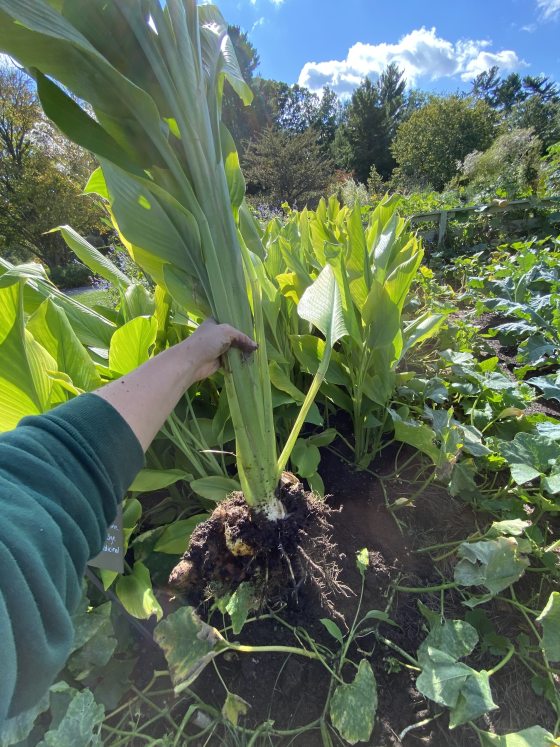
Turmeric leaves and rhizomes, shown here during harvesting. Photo by Alex Correia.
Dwarf cardamom (Elettaria cardamomum) is similar in form and texture to ginger and turmeric, with broad green leaves. However, it is wonderfully fragrant when brushed. It also prefers some shade and makes and excellent porch plant during the summer (it will fill a pot pretty quickly over the summer) and houseplant over the winter. When we overwinter them, I take them out of the pot, use a shovel to divide them by cutting in half through the tangle of rhizomes, and then pot up a portion that is no larger than half of the original plant—and then what’s left can be potted up to keep or can be shared.
Coffee (Coffea arabica) is a woody shrub that also prefers some shade. It makes an excellent houseplant over the winter, and can be moved outdoors in the summer, when it will flower and produce a new crop of small red fruits. It grows quickly and can become a large shrub in just a few short years.
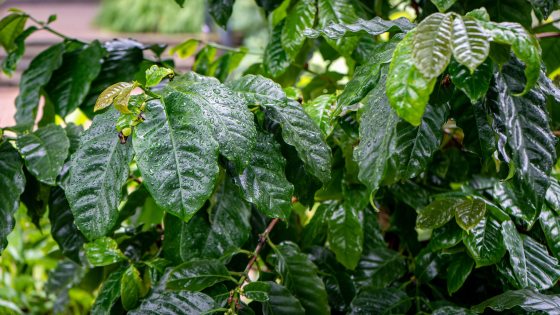
The coffee plant is known for its attractive dark, glossy foliage. It develops white flowers along the stems, which then develop into red fruits that house the seed we know as coffee beans. Photo by Carol Gross.
Lemongrass (Cymbopogon citratus) is another herb that is easy to grow in the summer and prefers full sun. The blue-green grassy foliage is an attractive texture in the garden. It is a clumping grass that expands over the course of the summer. Use the leaves for tea or cut out the fibrous bulbs to use in fragrant curry pastes and soup stocks.
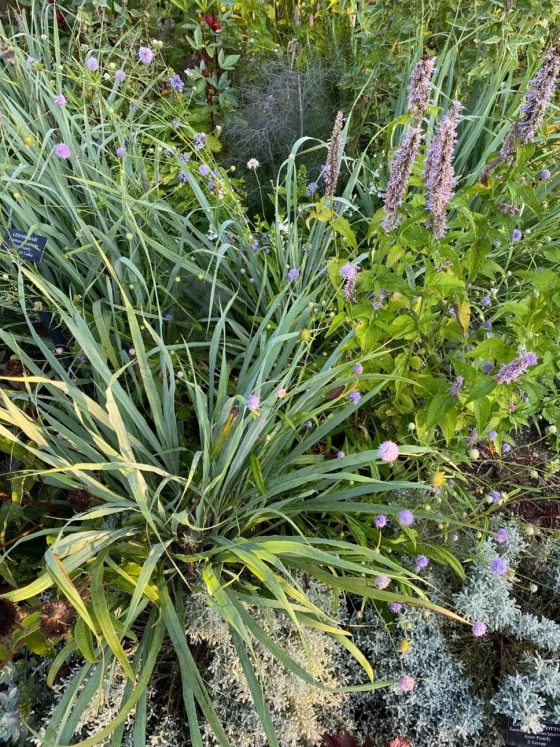
When I dig lemongrass (shown in the bottom left of this photo) in the fall, I store several bulbs in the freezer for these uses over the winter, and pot up a few to grow in the greenhouse for the following year. Photo by Alex Correia.
Roselle (Hibiscus sabdariffa) is an edible hibiscus used to make a red beverage that is popular in many different cultures. This very ornamental plant looks great planted into mixed beds and borders, will put on a lot of growth in one season, sporting red stems and leaf veins, and small creamy malva flowers that will develop succulent red calyces. These calyces are used to make jams and jellies or can be dried to make tea. The leaves are also edible and have a tart flavor, as do the calyces. In the heat of summer, it will grow rapidly, reaching 4 feet in height in favorable conditions, so be sure to give it plenty of space and make a stake to support its weight.
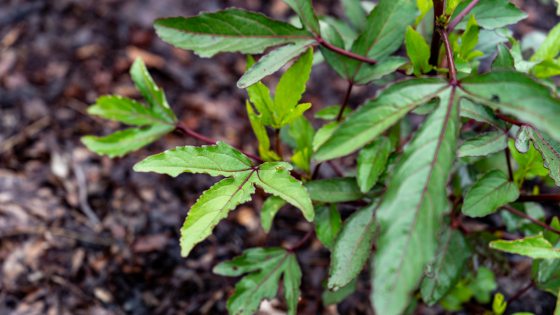
Roselle will get beautiful white hibiscus flowers and shiny red fruits, but even just its glossy leaves and red stems make it an attractive garden plant. Pictured here is the cultivar ‘Thai Red’. Photo by Carol Gross.
Aquatic herbs can be grown in water tight pots. Water-spinach (Ipomoea aquatica) is related to morning glory and sweet potatoes. It is widely cultivated in east and southeast Asia, where the greens are cooked like a spinach. Taro (Colocasia esculenta) is a species of elephant ear that can be grown in regular garden soil but can also be grown as an aquatic plant. It is widely cultivated in Hawaii where it is used to make poi. Pots are a great way to grow aquatic plants without investing in a pond. Any container will work as long as it is completely waterproof and will not drain. Fill the pot up three-quarters of the way with plain top soil and then fill to the brim with water. Once the soil settles into mud, plant your aquatics into the mud and keep the water level full. Use pond dye to ward off algae and mosquito dunks to prevent mosquitos. We like to grow lotus, water-chestnuts, water-spinach, and taro this way.
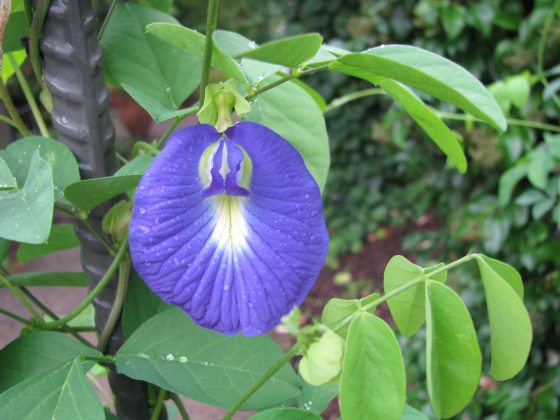
Butterfly pea (Clitoria ternatea) is a delicate vining legume with true blue pea-like flowers. The flowers can be dried and then used to make tea and dye that is vibrantly blue. The butterfly pea’s climbing vine will need a trellis to support it.
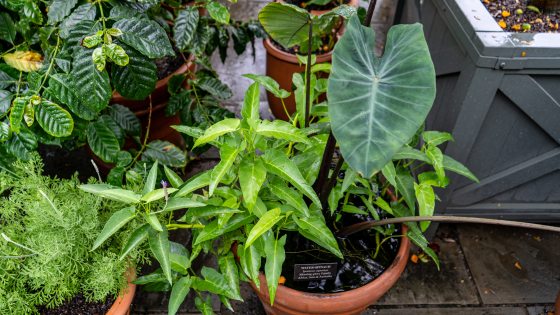
You will see many species of citrus displayed in the Idea Garden’s Container Garden, which include key lime (Citrus × aurantiifolia), yuzu lemon (Citrus × junos), kumquats (Citrus japonica), and mandarinquats (Citrus ‘Indio’). Citrus can be overwintered indoors and brought back outside when the weather evens out in May. Citrus trees need as much light as you can give them and you should be careful not to be overwater them. It is normal for citrus to turn slightly yellow over the winter, as the lower light prevents the plants from photosynthesizing as much as they would during the summer. It is also normal for the plants to shed a few leaves in response to the shock of a new environment when being moved outdoors or indoors.

Mandarinquat, or a cross between a mandarin and kumquat, has an edible peel but is far sweeter than a kumquat. Photo by Carol Gross.
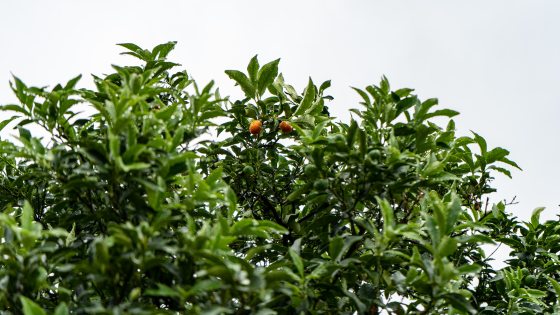
Kumquats begin to appear at the top of the tree. Photo by Carol Gross.
Come see these tropical beauties for yourself in our Idea Garden, most of which are displayed in our Container Garden, which provides plenty of inspiration outdoor spaces both large and small.
